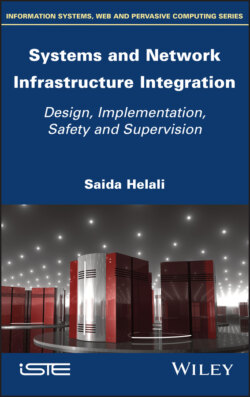Systems and Network Infrastructure Integration

Реклама. ООО «ЛитРес», ИНН: 7719571260.
Оглавление
Saida Helali. Systems and Network Infrastructure Integration
Table of Contents
List of Tables
List of Illustrations
Guide
Pages
Systems and Network Infrastructure Integration. Design, Implementation, Safety and Supervision
Preface
1
Introduction to Project Management
1.1. Introduction
1.2. Project management
1.3. Project management methods and tools
1.3.1. Gantt diagram
1.3.2. RACI (Responsible, Accountable, Consulted, Informed) matrix
1.3.3. The concept of specifications
1.4. Chapter summary
Note
2. Simulating Network Architectures with GNS3
2.1. Introduction
2.2. Definition
2.3. Introduction to GNS3
2.3.1. Functionalities of GNS3
2.3.2. Limitations
2.3.3. GNS3 installation
2.3.4. Getting started with GNS3
2.3.4.1. Integration of IOS image
IDLE PC
2.3.4.2. Constructing a simple network topology
2.3.4.3. Configuring a router
2.3.4.4. Adding virtual systems
Method 1 (cloud)
Method 2
2.4. Chapter summary
Note
3 Green IT
3.1. Introduction
3.2. Introduction of concept
3.3. Green IT trigger factors
3.4. Benefits of Green IT
3.5. The lifecycle of ICTs
3.6. Mechanisms and technical solutions for the implementation of a Green IT infrastructure
3.7. Green IT labels and standards
3.8. Some examples of Eco-ICTs
3.9 Chapter summary
Note
4 Design of Network Infrastructures
4.1 Introduction
4.2. The founding principles of networks. 4.2.1.Definition and preliminaries
4.2.2. Classification of digital data networks
4.2.3. Components of a network. 4.2.3.1. Hardware part
4.2.3.2. Software part
The OSI model
Functions of hardware layers
Functions of software layers
The TCP/IP model
4.2.4. Measuring network performance
4.2.5. Concepts of collision domain/broadcast domain and VLANs
4.3. Methods and models of IT network design
4.3.1. Principles of structured engineering
4.3.1.1. Hierarchical network model
4.3.1.2. Design in Cisco modules
4.4. Assessment of needs and choice of equipment
Some design rules
4.5. Chapter summary
Note
5 Network Services
5.1. Introduction
5.2. DHCP service. 5.2.1. Introduction
5.2.2. Operating principle
5.2.3. Renewal of lease
5.2.4. The concept of a DHCP relay
5.3. DNS service. 5.3.1. Introduction
5.3.2. Operating principle
5.4. LDAP service. 5.4.1. Introduction
5.4.2. LDAP protocol
5.4.3. LDAP directory
5.5. E-mail service. 5.5.1. Introduction
5.5.2. Architecture and operating principle
5.5.3. Protocols involved
5.6. Web server. 5.6.1. Introduction
5.6.2. Operating principle
5.6.3. The principle of virtual hosting
5.6.3.1. Virtual hosting by network address (IP/TCP port)
5.6.3.2. Virtual hosting by names
5.6.3.3. Virtual hosting by name and by IP
5.7. FTP file transfer service. 5.7.1. Definition
5.7.2. Operating principle
5.7.3. Types
5.8. Chapter summary
Note
6 System and Network Security
6.1. Introduction
6.2. Definitions, challenges and basic concepts
6.3. Threats/attacks
6.3.1. Access attacks
6.3.2. Modification attacks
6.3.3. Saturation attacks
6.3.4. Repudiation attacks
6.4. Security mechanisms
6.4.1. Encryption tools
6.4.2. Antivirus programs
6.4.3. Firewalls/IDS and IPS. 6.4.3.1. Firewalls
6.4.3.2. Intrusion detection systems (IDS) and intrusion prevention systems (IPS)
6.4.4. VPNs
6.4.5. Other means of security. 6.4.5.1. VLANs
6.4.5.2. Means of authentication
6.4.5.3. Logical access control
6.4.5.4. Physical security of equipment and premises
6.4.5.5. NAT (Network Address Translation)
6.4.5.6. NAC (Network Access Control)
6.4.5.7. Logging and audit
6.4.5.8. Backups
6.4.5.9. Training and awareness
6.5. Security management systems: norms and security policies. 6.5.1. Norms
6.5.2. The idea of security policy
6.6. Chapter summary
Note
7 Virtualization and Cloud Computing
7.1. Introduction
7.2. Virtualization. 7.2.1. Definition
7.2.2. Benefits of virtualization
7.2.3. Areas of application. 7.2.3.1. Virtualization of applications
7.2.3.2. Virtualization of servers
7.2.3.3. Virtualization of storage
7.2.3.4. Virtualization of networks
7.2.3.5. Virtualization of workstations
7.2.4. Categories of virtualization
7.2.4.1, Virtualization by isolation
7.2.4.2. Paravirtualization or type 1 hypervisor
7.2.4.3. Complete virtualization
7.2.4.4. Hardware-assisted virtualization
7.2.5. Limits of virtualization
7.3. Cloud computing. 7.3.1. Definitions
7.3.2. Leverage factors and generic principles
7.3.3. Architecture models
7.3.3.1. IaaS (Infrastructure as a Service)
7.3.3.2. PaaS (Platform as a Service)
7.3.3.3. SaaS (Software as a Service)
7.3.4. Types of cloud
7.3.5. Areas of application
7.3.6. Advantages and limitations
7.4. Chapter summary
Note
8 Quality of Service and High Availability
8.1. Introduction
8.2. Quality of service. 8.2.1. Motivation
8.2.2. Definition(s)
8.2.3. Objectives of QoS
8.2.4. Metrics of QoS
8.2.5. General principles of QoS
8.2.5.1. Classification
8.2.5.2. Queuing management
8.2.5.3. Scheduling
8.2.5.4. Traffic policing/shaping
8.2.6. QoS mechanisms
8.2.6.1. In the transport layer
8.2.6.2. In the network layer
IntServ
DiffServ
8.2.6.3. In the data link layer
8.2.6.4. Applications. Application 1:QoS configuration for routers
Stage 1: creation of class-map or flow classes
Stage 2: creation of policy-map
Stage 3: application of policy-map
Application 2: QoS configuration for switches (general principles)
Configuration according to ports
Application 3: QoS configuration at a level 3 switch with VoIP management
First architecture
Second architecture
8.3. High availability
8.3.1. Redundancy in the physical layer
8.3.2. Redundancy in the data link layer. 8.3.2.1. STP protocol
8.3.2.2. EtherChannel
Example of manual configuration
Example of configuration with thePAgPet andLCAP protocols
8.3.3. Redundancy in the network layer
8.3.3.1. HSRP (Hot Standby Router Protocol)
8.3.3.2. VRRP (Virtual Router Redundancy Protocol)
8.3.3.3. GLBP (Gateway Load Balancing Protocol)
Application: configuration of HSRP protocol
Configuration of Router 1
Configuration of Router 2
8.3.4. Redundancy in the application layer
8.4. Chapter summary
Notes
9 Monitoring Systems and Networks
9.1. Introduction
9.2. Main concepts of network and service supervision. 9.2.1. Definition
9.2.2. Challenges of monitoring
9.2.3. Typology
9.3. Monitoring protocols. 9.3.1. SNMP protocol (Simple Network Management Protocol)
9.3.2. WMI (Windows Management Instrumentation)
9.3.3. WS-Management (Web Services for Management)
9.3.4. IPMI (Intelligent Platform Management Interface)
9.3.5. NetFlow/IPFIX
9.3.6. Netconf
9.4. Monitoring tools
9.4.1. Commercial monitoring solutions (HP OpenView, Tivoli) and software publisher solutions
9.4.1.1. IBM Tivoli Monitoring
9.4.1.2. HP-OpenView
9.4.2. Free monitoring solutions
9.4.2.1. Nagios
9.4.2.2. Centreon
9.4.2.3. Shinken
9.4.2.4. Zabbix
9.4.2.5. FAN (FullyAutomatedNagios)
9.4.2.6. EyesOfNetwork (E.O.N.)
9.5. Chapter summary
Note
References
Index. A, B, C
D, E, F
G, H, I
J, L, M
N, P, Q
R, S, T
V, W, Z
Other titles from. in Information Systems, Web and Pervasive Computing. 2020
2019
2018
2017
2016
2015
2014
2013
2012
2011
2010
2009
2008
2007
2006
WILEY END USER LICENSE AGREEMENT
Отрывок из книги
Series Editor Jean-Charles Pomerol
Saida Helali
.....
– Who will use the proposed solution? With what benefits?
– What will be the solution's environment?
.....